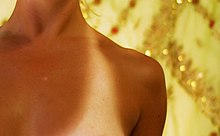Tanned
Tanning is the natural darkening of the skin as self-protection against damage from exposure to ultraviolet radiation from sunlight (or from other artificial sources such as a solarium). In the Today in many Western countries a tanned skin is aesthetically desirable, while Eastern cultures appreciate a paler complexion. Excessive sunbathing causes damage to the body, from skin irritations and sunburns to mutagenic appearances and the development of cancer.
In ancient times, people bleached their skin with products known today to be toxic. For example, as early as 400 BC, the Greeks bleached their facial skin with powders made from lead carbonate.[citation needed] Poppaea Sabina, wife of the Roman emperor Nero, followed this custom. In the 16th century, some Italian women used arsenic to give their faces a translucent appearance.[quote required] But ever since French designer Coco Chanel popularized the tanning craze in the early 1920s after a vacation on the French Riviera, it became more widespread. Thus, many people spend whole hours sunbathing.
Causes and effects
Darkening of the skin is caused by an increase in a body pigment called melanin; This pigment is found in the cells of the epidermis and is synthesized by exposing it to ultraviolet light radiation existing in the light spectrum of sunlight. Melanin is produced specifically by cells called melanocytes and its mission is protect the body from solar radiation, which could be harmful to health. The darkening of the skin becomes the color of bronze, hence its name. Depending on the genetics of the people, darkening can be achieved with greater or lesser progressivity. Tanning is a protective mechanism against the harmful effect that ultraviolet radiation produces on the skin, so it is not recommended to seek it, even if it is aesthetic, since it is harmful to health.
The frequencies of sunlight responsible for exciting the synthesis of melanin are usually divided into two ranges UVA (range between 315 to 400 nm of wavelength) and UVB (from 280 to 315 nm of wavelength). Waves in the UVB range have higher energy than those from the UVA range and for this reason are more damaging to the skin.
Individuals differ in their sensitivity to sun exposure and in their ability to tan, particularly according to the type of skin pigmentation.
Health benefits
One of the main uses of sunbathing is to help the body to synthesise vitamin D, but remember that it behaves more like a (growth) hormone than a vitamin itself.
It has been proven that exposure to the Sun for a short period of time (usually between 5-10 minutes)[citation needed] of the arms and hands, two or three times a week, and a slight intake of vitamin supplements in the diet is sufficient to maintain a reasonable balance in the body's demand for vitamin D.
Vitamins D2 and D3 are found naturally in some foods, although they always provide limited amounts, the contribution produced by the skin being much greater due to exposure to type B ultraviolet rays (UVB). It is essential for growth, ossification and the body's defenses, being ingested in small doses with food, but the main mechanism being the synthesis of vitamin-hormone D in the skin from the Sun.
As an example:[citation required]
- Cod liver oil (1 tablespoon): 1360 UI D3
- Cooked tuna, sardines, herrings and salmon (85-100 g): 200-360 UI D3
- Setas shiitake: 100 IU D3 (fresh, 100 g), 1.600 IU D3 (secos, 100 g)
- Egg yolk: 20 IU D3, D2
- Enriched dairy products, orange juice or cereals (one ration): 60-100 UI D3, D2
- Body solar exposure to UVB (15 to 20 minutes at noon, in summer, a clear skin person): 10,000 IU D3
Vitamin D
The body level of vitamin D is estimated from the serum concentration of 25D. Concentrations of 30-40 nanograms per mL of blood are sufficient for bone health, with greater benefits at higher concentrations. Concentrations below 30 endanger health, as well as levels above 150 (excessive levels of calcium in the blood and tissues can be toxic).[citation needed]
Above 150 ng -Toxic / 30-60 ng -optimal / 20-29 ng -Sufficient / 9-19 ng - Deficiency (rickets, increased risk of cancer, failures in antimicrobial responses).
Precautions
People with fair skin can get skin burns, so it is recommended to use sun protection creams and avoid the hours when sunlight is more intense, between 12 and 16.
The maximum recommended tanning time between those hours without protection is 45 minutes.[citation needed] Excessive exposure to the sun or tanning beds can cause skin cancer. fur.
Tanorexia
Exposure to sunlight has been shown to have addictive properties, by releasing certain opioids in the brain and that is why some people end up developing a psychiatric condition called tanorexia, which describes the obsessive need to tan.
Contrary to popular belief, there is no such thing as a 'healthy tan'; that is, a level of tanning that turns the skin dark without causing damage to the body. Therefore, all tanning is taken dermatologically as a natural reaction of the body directly proportional to the damage that it is perceiving in its exposure to ultraviolet radiation. (citation needed)
Contenido relacionado
Category: Drugs
John Locke
The Borinqueña

